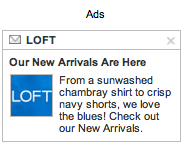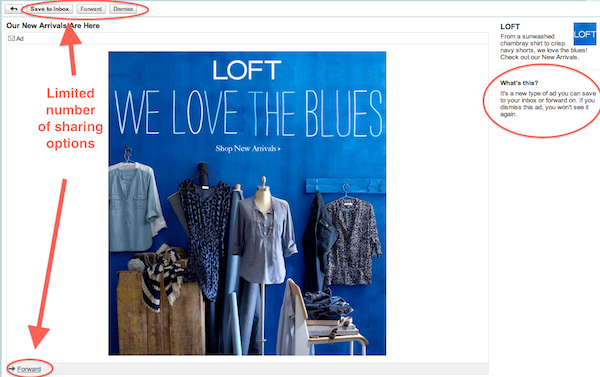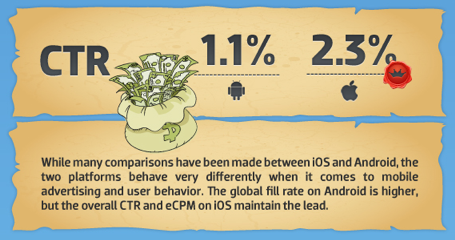Will New Gmail Ad Formats Be Totally Worth Dating, Engaging, Marrying & Having Babies With?
If you use Gmail in the U.S. then you may have spotted them already. Namely, glimpses of the new ad formats that Gmail has been promising for awhile. If you haven’t yet, what you are missing is not spectacular but definitely interesting – ‘sendable ads’. This is an interesting development as the general consensus was that new Gmail ad formats would be more geo-targeted and driven by the Google Offers platform (which is heavily email based anyway).
Sharing is part of the reason platforms like Groupon and other daily deal sites have grown so rapidly as the limited time offer relies on group buying to make it work. To qualify for the deal, enough people have to buy it – and so the message spreads like wildfire.
However, currently the new Gmail ads have more in common with Facebook ads than they do with traditional Google AdSense ads.
Rather than being full image display ads, they are text ads with small ‘avatar’ style images. The advertiser name is featured in what ostensibly is a ‘subject line’, indicated by what is typically an unread mail icon. The position of these ads is under the new people widget that appears in the top right corner and above the contextual AdSense ads.
All of this contributes to the feeling that these ads are more like Facebook’s ‘earned media’ ad format.
Compare: (Gmail)

To: (Facebook)

Similar to Facebook Ads which encourage you to like a page, which will then filter into your friends’ newsfeeds, the Gmail ads only offer the ability to clickthrough yourself, save to your inbox or forward to a friend. They offer much more limited sharing in that sense but like Facebook you can close an ad you don’t like simply by hitting the ‘dismiss’ button – all these metrics are useful for targeting.

To be fair, the comparison to Facebook is arguably spurious – on a feature comparison alone, “ads that you can forward” were actually first ‘pioneered’ (seems like the wrong word for such a simple idea) by Apple iAds.
Either way, sendable ads is an interesting move in light of a recent blog post by analytics guru, Avinash Kaushik, in which he argues that, “Email = totally worth dating, engaging, marrying and having babies with.” The thinking goes that as email marketing is completely permission based there is a lot of room to optimize your messaging and measure it’s impact. Open rates from email lead to obvious engagement metrics to monitor such as clickthrough rate, bounce rate, depth of visit and actions completed. He goes on to say that whilst these same metrics are available from search, search revolves around intent, whereas email is all about permission and retaining the ability to repeatedly contact a user.
So, with that in mind, these new GMail ads might enable a different type of messaging to be tested in this environment. Rather than focussing on user intention and relevance, there may be a different type of brand message or a opportunity to focus on audience segmentation. Presumably, with the power of Google behind them, advertisers may even be able to tap into Google’s own ability to segment the interests of GMail users.
With Gmail on every Android device, and Google pretty much owning most of the world’s mobile inventory via AdMob, perhaps an iAD like experience is a direction they could take. Alas, I can only speculate, but an infographic published by Inner-active today shows that iAds have a better clickthrough rate than those on Android. Google does stand to benefit from a new type of earned media format.

By way of an official comment a Google spokesperson told Search Engine Watch (SEW):
“On July 14 we started testing a new ad format with a small number of Gmail users in the US. The ads are designed specifically for Gmail and look and function a little differently from regular text ads. The new format allows people to interact with ads within Gmail and is the latest example of our efforts to make ads more useful and relevant. It’s an experiment, so it’s not yet available to all advertisers and we’re not sharing details on participants at this time.”
Google confirmed that some advertisers offered local daily deals. This is what we were expecting to hear, especially in light of a recent BIA/Kelsey report, which projects that locally targeted ads will make up 70% of mobile ad spending by 2015. Geo-targeted offers should be something that Google can easily and effectively offer potential Gmail advertisers.
The Google spokesperson went on to say, “Users can forward the ads, but we don’t keep track of who they forward them to. And of course, Google does not and will never rent, sell or share information that personally identifies users for marketing purposes without their express permission.” Google also told SEW that there are currently no plans to enable users to ‘+1’ these ads to share on Google+.
Nonetheless, the more social nature of these ads is plain to see (even if the features are somewhat limited) and lends itself very well to being an ad format on a social network. Traditionally ads are difficult to target to a social network but if we speculate on the ad targeting signals mobile data affords them, daily deals could have real traction on Google+ due to group texting features such as +Huddle. Thus Google could be well placed to mop up some of that projected local ad spend in mobile markets.
These ad formats make very effective use of a small amount of screen estate to potentially lead users into a richer “brand experience” in the future. Yet, rather than targeting, it seems to me that the test is really about answering the question of whether people will notice these new ad formats and interact with them (regardless of whether it is in email or a social network).
So, more to the point is the fact that these new ad formats have already caught my attention. Somehow, until these ads showed up, I was completely unconscious of the fact that I just don’t even see contextual ads in GMail – they are just a mess of text to the side of my emails that I can easily ignore. Whereas these new ads show up like little badges and there is something curiously tempting about them – like the unread message marker is working subconsciously on my brain.
The actual content provided by advertisers so far has been tedious, unappealing or vague. However, they are forgiven for not bombarding me with display advertising and moving graphics. The discreetness works, and in many cases, there is something rewarding about a large, good looking, original and creative image in the email. It’s easy to imagine Vogue-style, or magazine like, print (even better examples here) ads re-emerging in the online space.
Furthermore, the focussed browsing behavior of email (which is essentially getting socialized anyway by so many social notifications to one’s inbox), means that if Google can target the right advertisers to Gmail users, they may be able to strike gold on dwell time metrics for ad engagement. HTML 5 could be great here – or the interactivity you see on with Apple iADs.
So, with Google+ users actively circling, listing and sharing their interests, and the contextual data from email scanning that we have already given Gmail permission to use, the question of these new ad formats really could be, “will we be taking email ads to bed with us?”